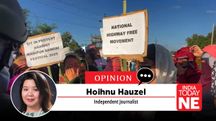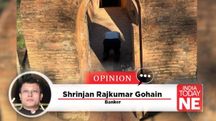Article 371C Was Never Meant to Be a Blank Cheque for Hill-Valley Divide in Manipur
A familiar pattern has emerged in Manipur in the last few years, many tribal civil servants (IAS, IPS, IRS) spend their entire careers posted outside the state, enjoying the comforts of Delhi, Mumbai or Bengaluru. When retirement brings them home, most choose, for reasons of security, healthcare, and family convenience, to settle in the relative calm of Imphal valley rather than return to their native villages.

A familiar pattern has emerged in Manipur in the last few years, many tribal civil servants (IAS, IPS, IRS) spend their entire careers posted outside the state, enjoying the comforts of Delhi, Mumbai or Bengaluru. When retirement brings them home, most choose, for reasons of security, healthcare, and family convenience, to settle in the relative calm of Imphal valley rather than return to their native villages.
Only in the later years do some rediscover a deep public voice for the hill areas. With the authority of past office and the freedom that retirement brings, they draft memoranda, address press conferences, and appeal directly to the President or the Prime Minister, often framing demands in the strongest possible terms (Sixth Schedule, separate administration, or a separate hill budget under Article 371C) that they know are constitutionally impossible.
The latest example is the 15 November 2025 representation by a retired Principal Chief Commissioner of Income Tax who, after decades of service far from the hills, now urges the President to create a separate hill treasury under the authority of Article 371C, a provision that grants no such power. The timing is predictable: the voice grows loudest when personal influence is weakest and accountability is zero.
Similar petition of K. Timothy Zimik, like Manipur Outer MP Alfred Arthur’s Budget-session demand and the Tangkhul Naga Long’s May 2025 call for “bifurcated budgets”, rests on a fundamental misreading of Article 371C. None of these documents can point to a single clause that authorises the President to create a separate hill treasury or split the state’s finances along ethnic-geographical lines. They selectively quote the 1972 Presidential Order’s references to HAC scrutiny of budgets, while ignoring that such scrutiny is consultative, not binding, and certainly not a mandate for fiscal division.
Having said that, the hill communities certainly deserve powerful, consistent advocacy throughout the decades, not only in the autumn of distinguished careers. What they need most are solutions grounded in the Constitution as it stands, advanced by voices that have walked with them at every stage, not just when the final chapter approaches.
Manipur keeps burning, and in the smoke one constitutional clause keeps being held up as both sword and shield: Article 371C.
In the past thirty months it has been invoked to justify every demand on the spectrum: from modest calls for greater devolution to Autonomous District Councils, to the Sixth Schedule, to a separate hill budget enforced directly by the President, and, in the most extreme voices, to a separate administration or state.All these demands share one common error: they treat Article 371C as if it were an open-ended charter of tribal autonomy. It is not. It never was.
Article 371C is, by design and by text, a temporary and transitional provision meant to ensure balanced development of the hill areas within the unified framework of Manipur, not to carve out autonomous tribal enclaves. It was never intended, and constitutionally cannot be stretched, to deliver the legislative, financial, or judicial autonomy that only the Sixth Schedule can provide.
Every demand that treats 371C as a stepping-stone—or worse, as legal justification—for such autonomy is therefore misplaced, misleading, and ultimately counterproductive. And the sooner this is acknowledged by all sides, the sooner the conversation can move from constitutional myth-making to practical, deliverable solutions.
Inserted through the Constitution (Twenty-seventh Amendment) Act, 1971, the full text of Article 371C is barely 200 words. It does exactly two things:
(a) It empowers the President to provide for the constitution and functions of a committee of the Legislative Assembly consisting of members elected from the hill areas, and for a “special responsibility” of the Governor to secure its proper functioning.
(b) It requires the Governor to make an annual (or more frequent) report to the President on the administration of the hill areas, and extends the executive power of the Union to give directions to the State on such administration.That is the entire provision.
That is all. There is no mention of a separate budget, no devolution of legislative powers over land and forests, no independent taxation authority, no tribal courts. These are the exact powers that the Sixth Schedule—found in Article 244(2) and Paragraph 20 of the Schedule—grants to the autonomous councils of Assam, Meghalaya, Tripura, and Mizoram. Manipur’s hill areas were consciously kept out of that framework in 1972, and Article 371C was the compromise substitute: a lighter, state-supervised arrangement meant to protect tribal interests without fracturing the state.
Article 371C was the compromise: a lighter, state-supervised safeguard meant to protect tribal interests without fracturing the newly created full state.The Autonomous District Councils created under the Manipur (Hill Areas) District Councils Act, 1971 are not, and were never intended to be, Sixth Schedule councils. They are subordinate bodies whose rules require the approval of the Hill Areas Committee, the state Assembly, and finally the Governor.
Their financial powers are negligible. The Deputy Commissioner, a state appointee, remains the real executive authority. This is not an accident of poor implementation; it is the deliberate architecture of the compromise reached in 1971–72.
To demand the Sixth Schedule, or a separate budget, “under Article 371C” is therefore constitutionally impossible. It is like demanding a doctorate degree on the strength of a high-school certificate. The two instruments belong to entirely different categories.
One is a constitutional speed-breaker meant to force the state government to consult tribal MLAs and allocate resources equitably; the other is a mini-legislature with its own treasury and courts. Confusing the two does not strengthen the tribal case—it weakens it by exposing it to easy legal dismissal.
On 15 November 2025, a detailed representation reached Rashtrapati Bhavan. Submitted by K. Timothy Zimik, a retired Principal Chief Commissioner of Income Tax and former Lok Sabha candidate, the document has rapidly become the new manifesto for the “separate budget” demand. It is emotionally powerful and factually flawed on almost every major point. Its six central claims are worth examining one by one.
First Claim: Article 371C and the 1972 Presidential Order empower the President to create a separate, independent budget for the hill areas.
Reality: Neither the article nor the 1972 Order contains a single word about budgets. The President’s power is limited to constituting the HAC and receiving reports. Creating a parallel treasury would require a constitutional amendment or a new law passed by Parliament. No executive order can achieve it under the guise of “implementing 371C”.
Second Claim: Over 51 % of all central funds devolved to Manipur are “attributable” to the hill areas under the 15th Finance Commission formula, and are being diverted to the valley.
Reality: The 15th Finance Commission uses area (15 %), forest cover (10 %), population (15 %), income distance (45 %), demographic performance (12.5 %), and tax effort (2.5 %) to determine the state’s total share from the divisible pool. The money is awarded to the State of Manipur, not to its geographical sub-regions. Once it reaches the state treasury, there is no constitutional tag saying “hill money” or “valley money”.
The same logic would require erstwhile state of Kashmir where Ladakh to receive 90 % of Jammu & Kashmir’s award or the tribal districts of Odisha to receive half of Odisha’s share. No Finance Commission has ever operated that way.
Third Claim: The Hill Areas Committee is “practically defunct” and its recommendations are routinely ignored.
Reality: The HAC meets regularly, examines every bill affecting the hill areas, and its recommendations are mandatory for the Assembly to consider under Rule 232A of the Manipur Legislative Assembly Rules of Procedure. Several bills have been amended or withdrawn because of HAC objections. The limitation is that recommendations are not binding in the final vote, a limitation written into Article 371C itself, not a conspiracy by valley MLAs.
Fourth Claim: Delimitation has been deliberately blocked by the valley to keep hill representation frozen at 20 seats.
Reality: Delimitation has been frozen across the entire North-East (including Manipur) by successive parliamentary enactments since 1976 for reasons of security and demographic sensitivity. The freeze applies equally to Nagaland, Arunachal Pradesh, Mizoram, and few tribal areas of Assam. When delimitation finally happens, the hills will almost certainly gain seats, but it is a national process, not something the Manipur Assembly can decide unilaterally.
Fifth Claim: The hills receive only a “fraction” of funds.
Reality: Between 2020-21 and 2024-25, ₹2,395.51 crore was sanctioned under the Central Road Infrastructure Fund (CRIF) for hill roads and bridges, against ₹1,300.21 crore for the valley, a 65 : 35 ratio. National highway projects in the same period: ₹8,542 crore for hill corridors, ₹352 crore for the valley. Tribal Affairs department (exclusively hills): over ₹4,800 crore since 2017. The hill share of plan expenditure has risen from roughly 10 % before 2017 to an estimated 30–35 % in 2024-25. The problem is not allocation; it is utilisation, halted by violence, blockades, and extortion.
The articles in 371C does contain two under-utilised but extremely powerful tools:The Governor’s “special responsibility” is not ceremonial; it is a constitutional duty independent of the Council of Ministers.
The President’s power to issue directions to the state government on the administration of the hill areas is binding.
If even one rigorous Governor’s report had been sent to the President in the last twenty-five years detailing the systematic non-utilisation of sanctioned funds, the Centre could have forced corrective action without touching the Constitution. Instead, the mechanism has been allowed to atrophy.
Manipur does not need two treasuries; it needs one state that works. The immediate, deliverable steps are clear:Resume and complete ADC elections without further delay. However, a separate budget enforced under Article 371C is constitutionally impossible, politically explosive, and practically useless as long as armed groups and blockades control large parts of the hill territory. It would simply create two parallel accounts in a state already torn by mistrust, guaranteeing permanent ethnic accounting and endless litigation over every rupee.
Article 371C is a modest, carefully worded constitutional clause meant to protect tribal interests inside a united Manipur, not to tear the state into two fiscal halves. It is a bridge, not a border.
The moment we start treating Article 371C as a blank cheque for hill-valley divide, two things happen at once. First, the Constitution is misread, because the provision simply does not contain those powers. Second, worst indeed, every overstated claim deepens the hill-valley divide, turns neighbours into permanent adversaries, and transforms Manipur into a conflict state where no one gains: development stalls, trust collapses, and violence finds new justifications.
That outcome is the precise negation of Article 371C, whose entire purpose in 1971 was to prevent the fragmentation of a small, multi-ethnic state and to guarantee balanced growth within a single, united Manipur.
Copyright©2025 Living Media India Limited. For reprint rights: Syndications Today









